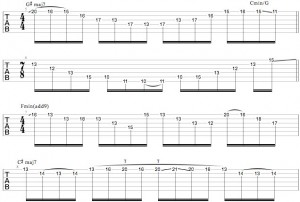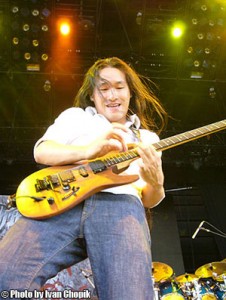Welcome to my fourth column/lesson. This time I would like to talk about a component of guitar playing that has always fascinated me: arpeggio permutations/fragments. Playing arpeggio fragments can make one’s playing more colorful, usually helping a musical phrase sound harmonically richer and more diverse.
| [flashvideo file=https://guitarmessenger.com/wp-content/uploads/2008/05/playlist1.xml width=320 height=390 playlist=bottom playlistsize=130 /] |
| Lesson Video |
Most of the time – in so called “heavy” music – lead guitar players will greatly underutilize arpeggios and their permutations. Typically, players tend to fall into the trap of working on a small number of possibilities/shapes and leaving it at that – always having only a few stock patterns to rely on. There is always the option of extending these arpeggio ideas and/or breaking them up into smaller fragments, which can be applied in a more original way into a given musical situation.
Consider some of the following when coming up with new arpeggios:
- Devise a new fingering
- Extend the arpeggios to include new/different tensions
- Extend the arpeggios to imply chords not being outlined by the rest of the group
- Try to “think outside the box,” work on different techniques in trying to apply arpeggios to a musical passage.
In this lesson I will talk about a specific fingering: the so called 2-1-2 technique – meaning that we will be playing each fragment as two notes (on 1 string) followed by a single note (on an adjacent string), followed by two more notes on the string following the previous one.
To play these ideas you should sweep pick the arpeggio fragments – this will create a more fluid/flowing sound. So, the pick stroke motion for an ascending arpeggio figure (with the 2-1-2 fingering) will usually be something like: (U, D) (D) (D, U). Notice the consecutive down strokes allow you to rake through the strings andeconomically move across them with as little wasted motion as possible.
Example 1
EXAMPLE 1 is a warm up type of exercise that helps explore permutations that move across all 6 strings using this 2-1-2 fingering.
The four arpeggios for these examples are:
- Dmaj7 (9)
- Gmaj7 (9)
- A7/C#
- Bm7/F#
Example 1A is the “double ascending” version – ascending 5-note shapes, as four groups of quintuplets.
Example 1B is the “double descending” version: descending 5-note shapes, as four groups of quintuplets.
These first 2 examples are the easiest ones to play, because the “between 5-note shapes picking” follows the same direction through adjacent strings. Another possibility is to play these shapes inverting one of the two directions – which will obviously lead to string-skips:
Example 1C: ascending 5-note shapes, and descending 4 groups way.
Example 1D: descending 5-note shapes, and ascending 4 groups way.
Notice how these last 2 examples are harder to play and imply a more technical picking pattern. Note how the picking direction between each quintuplet stays the same, but requires the double string-skip to start the new group. It may take awhile to get cleanliness and fluidity out of it, so I would suggest that you isolate this picking movement and practice it really slowly. Make sure all notes come out even and with the desired dynamic control.
Example 1 E is a mix between descending and ascending 5-note shapes. In this case the phrase implies a group of 9+13+13+13 across the 2 bars (as opposed to 5+5+5+5 for each bar). These rhythmic patterns that break the traditional rhythmic groupings of a common meter tend to give the listener a feeling that the group is floating over the beat. The right hand movement is again what needs to be looked at and studied carefully, especially when switching between shapes.
Example 2
EXAMPLE 2 takes the same idea and applies somewhat more horizontally across the neck. It is based on descending arpeggios played on only 2 different sets of strings. Just like examples 1C and 1D, it requires a double string-skip in parts. The arpeggios in this case are based on these chords:
- A7 (9)
- F#m7 (b5 b9)
- C7 (9)
- Bm7 (b5 b9)
- Ebm7 (b5 b9)
- Cm7 (b5 b9)
Example 3
EXAMPLE 3 combines the double ascending 5 note shapes (Example 1 A) with the ascending/descending pattern seen in Example 1 E. In this case, the shapes move in all the directions: vertically, diagonally, and horizontally. This example is based on this series of arpeggios:
- Em7 (11)
- Bm7 (11)
- Esus4 (9 13)
- Am7 (11)
- Dsus4 (9 13)
- Em7
- G7
Example 4
EXAMPLE 4 mixes the 2-1-2 shapes seen before (5-note groups) with 4-note ones. The first half of the lick is “double ascending,” while the second half is “double descending.” A good tool to have in your arsenal is how to mix different rhythms inside the same line/phrase to give an unexpected feel to a musical phrase.
These are the arpeggios played in this example:
- Em7
- Em (11)
- Bm7 (11)
- A7
- Em
- Gmaj7
- Em7
Example 5
EXAMPLE 5 is our final example; it shows how we can incorporate these ideas inside a more varied and musical phrase. This line in fact uses different playing techniques and emphasizes different harmonic colors/tensions, even though it is based entirely on the C# Phrygian Dominant scale (5th mode of the F# Harmonic Minor scale).
The arpeggios played at the end of measure 2, and throughout measure 3 are:
- C#7
- G#dim
- F#m (11)
I hope you enjoyed this lesson and stay tuned for more “Technical Difficulties.”

























